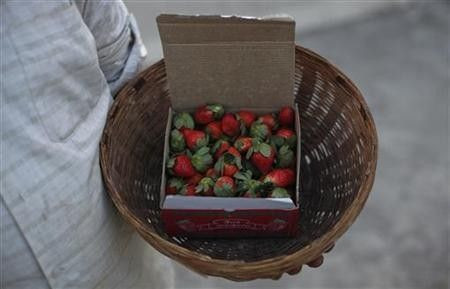Strawberries and Dreams in India's Hill Districts

Farmer Shripati Nana Jadhav has good reasons to be a fan of strawberries - they've funded construction of his simple, spacious house near the hill station of Panchgani and allowed him to send his four children to college.
Jadhav has been growing strawberries for more than 30 years, taking advantage of the temperate climate that lured the British from the coastal monsoon heat over 100 years ago to branch out from traditional cereal crops and sugar.
Returns from strawberries enabled me to make all three of my sons engineers, the 62-year-old Jadhav said, sitting on a flat bench bed in his airy home as he sipped traditional chai tea. Initially, I built a room and as strawberries started giving me returns, I expanded my home by building (more) rooms.
India, one of the world's largest producers of wheat, rice and corn, is a negligible player in the world strawberry market of over four million tonnes, where the United States is the biggest producer and one of the largest consumers.
The south Asian country grows very little in the way of soft fruits, partly as it has few temperate areas and also because transporting the delicate produce has been extremely difficult on its potholed, clogged roads and uncertain railway network.
But in recent years, improved roads have put high-tech Bangalore and Hyderabad -- some 790 and 530 km away respectively - within reach of Bhilar village for sales, and made it quicker to freight to the mega-city of Mumbai, just 290 km north.
This year, Jadhav has planted strawberries on half an acre at a cost of 100,000 rupees and expects to reap at least 200,000 rupees from the crop.
The rest of his gently sloping, terraced land is largely laid to wheat, planted at a cost of 10,000 rupees and which Jadhav says will bring in at most 20,000 rupees.
For more than three decades I have been cultivating strawberries. The crop has been consistently giving me good returns, better than other crops like wheat, paddy and vegetables, he added.
JAM TODAY, FRESH FRUIT TOMORROW?
Indian strawberry production saw something of a revolution in 1992, when seedlings from California were introduced, boosting yields and fruit quality. Irrigation also improved.
The Panchgani-Mahabaleshwar region grows more than 85 percent of the country's strawberries and roads in the area are festooned with billboards bright with advertisements for the fruit. Roadside halts offer blush pink ice cream or locally-bottled jams and strawberry syrup.
Output from the region should reach 18,000 tonnes in the year to June 30, 2012, from last year's 16,000 tonnes, as farmers plant the fruit on a larger area, said Krishna Bhilare, vice-president of the All India Strawberry Growers Association.
In the past four years, demand from the food processing industry has doubled. We are selling nearly 15 percent of the total production to food processors, Bhilare said. Retail chains like Reliance Fresh (owned by Reliance Industries) and Big Bazaar (owned by the Future Group) are buying directly from us, he added.
Bhilare feels it's only a matter of time before strawberries really take off with local palates, famous for their penchant for all things sweet but so far only finding wide use for strawberries in jelly-like jam for tourists to put on toast.
It is no longer a strange fruit for consumers. They know it and want to eat it, he added.
© Copyright Thomson Reuters 2024. All rights reserved.





















